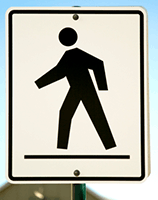Look Both Ways

Old School: Look to the left, look to the right, look to the left again and then cross.
New School: Look left, look straight into the intersection, look right and repeat before crossing the street
Crossing the road safely is a little more complicated these days than it used to be, but for good reason. Child pedestrian incidents are a leading cause of injury-related death for children under the age of 14, and unfortunately spring’s warm weather brings more child-pedestrian injuries and deaths than any other time of year. Safe Kids Canada’s Safe Kids Week (May 26 – June 1), is focused on Safe Roads, Safe Kids this year. And from the stats, it looks like it’s something we can all get better at, adult and child alike.
Small Cars Do Not Necessarily Go Faster than Big Cars
But kids think they do. It’s because they don’t have the overall cognitive, physical, sensory and auditory development to manage the potential danger (i.e. they can’t judge when a car will be close to them based on the speed it is travelling) and their lower eye-level limits their field of vision, decreasing their perception and ability to deal with oncoming traffic. Furthermore, they may not be able to identify colours and thus traffic signs and signals and their natural self-centeredness (definitely applies to our kids!) means they have a hard time believing that a driver could not see them. Crossing streets is a complex task—planning the route, detecting traffic, making decisions about the speed and distance away of vehicles, and ultimately whether or not to cross—and children are unable to grasp these concepts without repeated and reinforced guidance from parents and caregivers.













